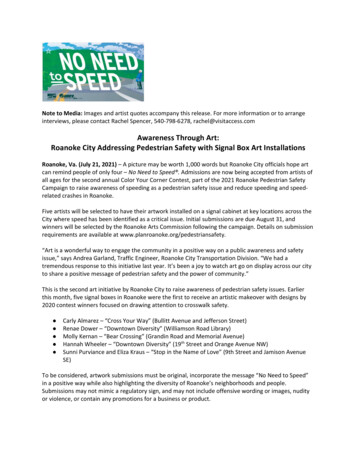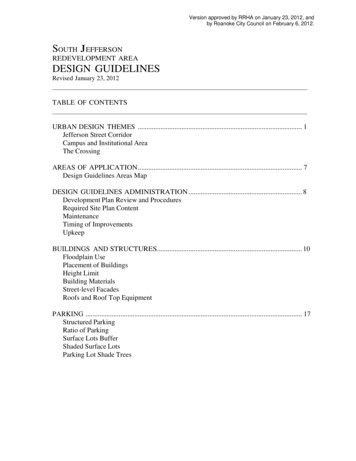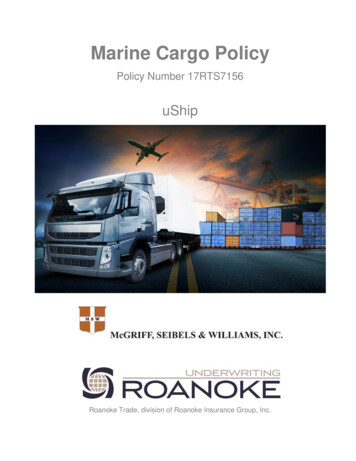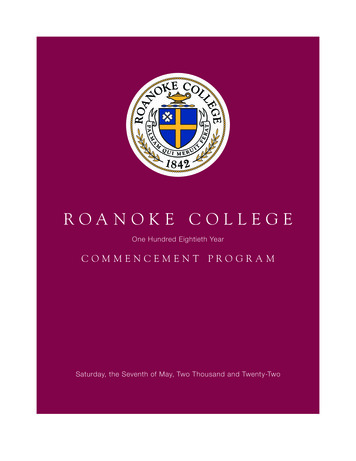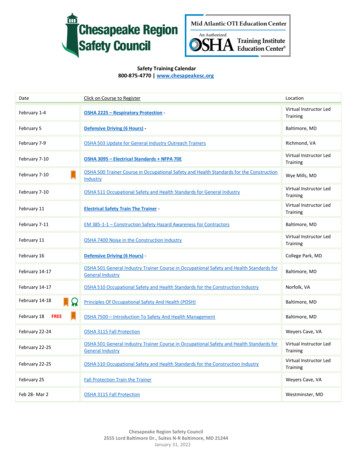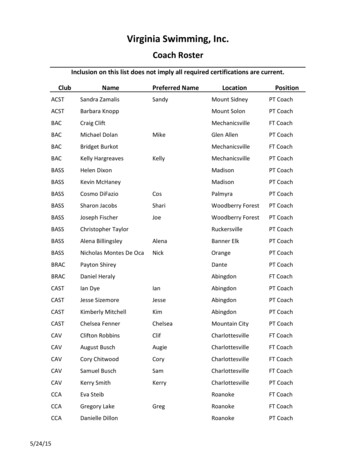
Transcription
EXECUTIVE SUMMARYDECEMBER 2021The Economic Value ofRoanoke-Chowan Community College
ROA N O K E - C H O WA N C O M M U N I T Y C O L L E G E ( R - C C C ) creates value in many ways. The college plays a key role in helping studentsincrease their employability and achieve their individual potential. The collegedraws students to the region, generating new dollars and opportunities for theR-CCC Service Area.1 R-CCC provides students with the education, training, andskills they need to have fulfilling and prosperous careers. Furthermore, R-CCCT H E R- C C C S E R V I C E A R E A, N Cis a place for students to meet new people, increase their self-confidence, andpromote their overall health and well-being.R-CCC influences both the lives of its students and the regional economy. Thecollege supports a variety of industries in the R-CCC Service Area, serves regionalbusinesses, and benefits society as a whole in North Carolina from an expandedeconomy and improved quality of life. Additionally, the benefits created byR-CCC extend to the state and local government through increased tax revenuesR-CCC influencesboth the lives ofits students and theregional economy.and public sector savings.This study measures the economic impacts created by R-CCC on the businesscommunity and the benefits the college generates in return for the investments made by its key stakeholder groups—students, taxpayers, and society. Thefollowing two analyses are presented:Economic impact analysisInvestment analysisAll results reflect employee, student, and financial data, provided by the college,for fiscal year (FY) 2019-20.2 Impacts on the R-CCC Service Area economy arereported under the economic impact analysis and are measured in terms ofadded income. The returns on investment to students, taxpayers, and societyin North Carolina are reported under the investment analysis.1For the purposes of this analysis, the R-CCC Service Area is comprised of Bertie, Hertford, and Northampton Counties.2Due to limited data availability, data from FY 2018-2019 were used as a proxy for revenues, expenditures, andnet grant aid.Introduction 2
ECONOMIC IMPACT ANALYSISR-CCC promotes economic growth in the R-CCC Service Area through its directexpenditures and the resulting expenditures of students and regional businesses.I M PAC T S C R E AT E D BYR- C C C I N F Y 201 9 - 20The college serves as an employer and buyer of goods and services for its day-today operations. The college’s activities attract students from outside the R-CCCService Area, whose expenditures benefit regional vendors. In addition, R-CCC isa primary source of higher education to the R-CCC Service Area residents and asupplier of trained workers to regional industries, enhancing overall productivityOperations spending impact 8.0 millionin the regional workforce.Operations spending impactR-CCC adds economic value to the R-CCC Service Area as anStudent spending impact 211.3 thousandemployer of regional residents and a large-scale buyer of goodsand services. In FY 2019-20, the college employed 115 full-time andpart-time faculty and staff, 89% of whom lived in the R-CCC Service Area. Totalpayroll at R-CCC was 6.8 million, much of which was spent in the region for groceries, mortgage and rent payments, dining out, and other household expenses.Alumni impact 24.9 millionIn addition, the college spent 2.6 million on day-to-day expenses related tofacilities, supplies, and professional services.R-CCC’s day-to-day operations spending added 8 million in income to theTOTAL ECONOMIC IMPACT 33 millionregion during the analysis year. This figure represents the college’s payroll, theORmultiplier effects generated by the in-region spending of the college and itsJobs supportedemployees, and a downward adjustment to account for funding that the collegereceived from regional sources. The 8 million in added income is equivalent to607supporting 132 jobs in the region.Student spending impactAround 32% of students attending R-CCC originated from outsidethe region in FY 2019-20, and some of these students relocated tothe R-CCC Service Area to attend R-CCC. These students may nothave come to the region if the college did not exist. In addition, some in-regionstudents, referred to as retained students, would have left the R-CCC Service Areaif not for the existence of R-CCC. While attending the college, these relocatedand retained students spent money on groceries, accommodation, transportation, and other household expenses. This spending generated 211.3 thousand inadded income for the regional economy in FY 2019-20, which supported sevenjobs in the R-CCC Service Area.Economic impact analysis3
Alumni impactThe education and training R-CCC provides for regional residents hasthe greatest impact. Since its establishment, students have studied atR-CCC Service Area. As a result of their education from R-CCC, the studentsreceive higher earnings and increase the productivity of the businesses thatemploy them. In FY 2019-20, R-CCC alumni generated 24.9 million in addedincome for the regional economy, which is equivalent to supporting 469 jobs.96100 81 52 52 48R-CCC and entered the regional workforce with greater knowledgeand new skills. Today, thousands of former R-CCC students are employed in theR- C C C I M PAC T S B Y I N D U S T R Y( J O B S S U P P O R T E D)Other Services (exceptPublic Administration)77Government, Non-Education50Total impactR-CCC added 33 million in income to the R-CCC Service Area economy duringthe analysis year, equal to the sum of the operations spending impact, the studentspending impact, and the alumni impact. For context, the 33 million impactwas equal to approximately 1.6% of the total gross regional product (GRP) of theR-CCC Service Area. This contribution that the college provided on its own waslarger than the entire Accommodation & Food Services industry in the region.R-CCC’s total impact can also be expressed in terms of jobs supported. The 33million impact supported 607 regional jobs, using the jobs-to-sales ratios specificto each industry in the region. This means that one out of every 45 jobs in theR-CCC Service Area is supported by the activities of R-CCC and its students. Inaddition, the 33 million, or 607 supported jobs, stemmed from different industrysectors. Among non-education industry sectors, R-CCC’s spending and alumniin the Other Services (except Public Administration) industry sector supported96 jobs in FY 2019-20. If the college did not exist, these impacts would not haveManufacturing49Health Care & Social Assistance46Retail TradeOne out of every45 jobs in theR-CCC Service Areais supported by theactivities of R-CCCand its students.been generated in the R-CCC Service Area.Economic impact analysis4
INVESTMENT ANALYSISAn investment analysis evaluates the costs associated with a proposed ventureagainst its expected benefits. If the benefits outweigh the costs, then the investment is financially worthwhile. The analysis presented here considers R-CCCas an investment from the perspectives of students, taxpayers, and societyin North Carolina.Student perspectiveIn FY 2019-20, R-CCC served 793 credit and 1,491 non-credit students.S T U D E N T S S E E A H I G H R AT EOF RETURN FOR THEIRI N V E S T M E N T I N R- C C CIn order to attend the college, the students paid for tuition, fees, books,and supplies. They also gave up money they would have otherwiseAverage annual return forR-CCC studentsearned had they been working instead of attending college. The total investmentmade by R-CCC’s students in FY 2019-20 amounted to a present value of 3.533.0%66 21 2million, equal to 0.9 thousand in out-of-pocket expenses and 2.5 million inStock market 30-yearaverage annual returnforgone time and money.In return for their investment, R-CCC’s students will receive a stream of higherfuture earnings that will continue to grow throughout their working lives. Forexample, the average R-CCC associate degree graduate from FY 2019-20 will seeannual earnings that are 7,000 higher than a person with a high school diplomaor equivalent working in North Carolina. Over a working lifetime, the benefits of10.6%Interest earned on savings account(National Rate Cap)0.8%Source: Forbes’ S&P 500, 1991-2020. FDIC.gov, 6-2021.the associate degree over a high school diploma will amount to an undiscountedvalue of 231 thousand in higher earnings per graduate. The present value of thecumulative higher future earnings that R-CCC’s FY 2019-20 students will receiveover their working careers is 21.4 million.The students’ benefit-cost ratio is 6.2. In other words, for every dollar studentsinvest in R-CCC in the form of out-of-pocket expenses and forgone time andmoney, they will receive a cumulative value of 6.20 in higher future earnings. High school 19,90042 536068 100The average associatedegree graduate fromR-CCC will see anincrease in earningsof 7,000 eachyear compared to aperson with a highschool diploma orequivalent working inNorth Carolina.High schoolCertificateAssociateBachelor's 25,000 28,500 32,000 47,400Source: Emsi Burning Glass employment data.Investment analysis5
Annually, the students’ investment in R-CCC has an average annual internalrate of return of 33.0%, which is impressive compared to the U.S. stock market’s30-year average rate of return of 10.6%.Taxpayer perspectiveR-CCC generates substantial benefits for taxpayers. These benefitsto taxpayers consist primarily of taxes that the state and local government will collect from the added revenue created in the state. AsR-CCC students will earn more, they will make higher tax payments throughouttheir working lives. Students’ employers will also make higher tax payments asthey increase their output and purchases of goods andservices. By the end of the FY 2019-20 students’ workinglives, the state and local government will have collecteda present value of 5.9 million in added taxes.Benefits to taxpayers will also consist of savings generatedby the improved lifestyles of R-CCC students and theTotal taxpayer benefits amount to 6.5 million, the present value sumof the added tax revenues andpublic sector savings.corresponding reduced government services. Educationis statistically correlated with a variety of lifestyle changes. The educationsthat R-CCC students receive will generate savings in three main categories:1) healthcare, 2) justice system, and 3) income assistance. Improved health willlower students’ demand for national health care services. In addition, costs relatedto the justice system will decrease. R-CCC students will be more employable,so their reduced demand for income assistance such as welfare and unemployment benefits will benefit taxpayers. For a list of study references, contactthe college for a copy of the main report. Altogether, the present value of thebenefits associated with an R-CCC education will generate 617 thousand insavings to state and local taxpayers.Total taxpayer benefits amount to 6.5 million, the present value sum of theadded taxes and public sector savings. Taxpayer costs are 7.5 million, equal tothe amount of state and local government funding R-CCC received in FY 2019-20.Social perspectiveSociety as a whole in North Carolina benefits from the presenceof R-CCC in two major ways. Primarily, society benefits from anincreased economic base in the state. This is attributed to the addedincome from students’ increased lifetime earnings (added student income) andincreased business output (added business income), which raise economicprosperity in North Carolina.Benefits to society also consist of the savings generated by the improved lifestyles of R-CCC students. As discussed in the previous section, education isstatistically correlated with a variety of lifestyle changes that generate socialsavings. Note that these costs are avoided by the consumers but are distinct fromSOCIAL BENEFITS IN NORTHCA R O L I N A F R O M R- C C CAdded incomefrom collegeactivities 6.5 million10 25263UAdded studentincome 43.1 million 68.5 millionAddedbusinessincome 17.3 millionTotal benefitsto societySocial savings 1.6 millionSource: Emsi Burning Glass impact model.Investment analysis6
the costs avoided by the taxpayers outlined above. Healthcare savings includeavoided medical costs associated with smoking, alcohol dependence, obesity,drug abuse, and depression. Justice system savings include avoided costs to theSTUDENT PERSPECTIVEgovernment and society due to less judicial activity. Income assistance savingsPresent value benefitsinclude reduced welfare and unemployment claims. For a list of study references,contact the college for a copy of the main report.Altogether, the social benefits of R-CCC equal a present value of 68.5 million.These benefits include 43.1 million in added student income, 17.3 million inadded business income, 6.5 million in added income from college activities,as well as 1.6 million in social savings related to health, crime, and incomeassistance in North Carolina. People in North Carolina invested a present value 21.4 millionPresent value costs 3.5 millionNet present value 18 millionBenefit-cost ratio6.2Rate of return33.0%total of 12.5 million in R-CCC in FY 2019-20. The cost includes all the collegeand student costs.The benefit-cost ratio for society is 5.5, equal to the 68.5 million in benefitsdivided by the 12.5 million in costs. In other words, for every dollar investedTAXPAYER PERSPECTIVEin R-CCC, people in North Carolina will receive a cumulative value of 5.50 inPresent value benefitsbenefits. The benefits of this investment will occur for as long as R-CCC’s FY 6.5 million2019-20 students remain employed in the state workforce.Present value costsSummary of investment analysis results 7.5 millionThe results of the analysis demonstrate that R-CCC is a strong investment for students and society. As shown, students receive a great return for their investmentsin an R-CCC education. From the taxpayers’ perspective, the benefits generatedSOCIAL PERSPECTIVEby the college and its students recover a significant portion of the costs borne byPresent value benefitstaxpayers and create a wide range of social benefits throughout North Carolina. 68.5 millionPresent value costs 12.5 millionNet present value 56 millionBenefit-cost ratio5.5Rate of returnn/a** The rate of return is not reported for thesocial perspective because the beneficiariesof the investment are not necessarily thesame as the original investors.Investment analysis7
CONCLUSIONThe results of this study demonstrate that R-CCC creates value from multipleperspectives. The college benefits regional businesses by increasing consumerspending in the region and supplying a steady flow of qualified, trained workersto the workforce. R-CCC enriches the lives of students by raising their lifetimeearnings and helping them achieve their individual potential. The college benefitsstate and local taxpayers through increased tax receipts and a reduced demandfor government-supported social services. Finally, R-CCC benefits society as aThe results of thisstudy demonstratethat R-CCC createsvalue from multipleperspectives.whole in North Carolina by creating a more prosperous economy and generatinga variety of savings through the improved lifestyles of students.About the studyData and assumptions used in the study are based on several sources, including the FY 2019-20 academic and financial reports from R-CCC, industry andemployment data from the U.S. Bureau of Labor Statistics and U.S. CensusBureau, outputs of Emsi Burning Glass’s Multi-Regional Social Accounting Matrixmodel, and a variety of studies and surveys relating education to social behavior.The study applies a conservative methodology and follows standard practiceusing only the most recognized indicators of economic impact and investmenteffectiveness. For a full description of the data and approach used in the study,please contact the college for a copy of the main report.Emsi Burning Glass provides colleges and universities with labor market data that helps create better outcomes for students, businesses,and communities. Our data, which cover more than 99% of the U.S. workforce, are compiled from a wide variety of government sources,job postings, and online profiles and résumés. Hundreds of institutions use Emsi Burning Glass to align programs with regional needs,drive enrollment, connect students with in-demand careers, track their alumni’s employment outcomes, and demonstrate their institution’seconomic impact on their region. Visit economicmodeling.com/higher-education to learn more or connect with us.Conclusion8
OANOKE-CHOWAN COMMUNITY COLLEGE (R-CCC) cre-ates value in many ways. The college plays a key role in helping students increase their employability and achieve their individual potential. The college draws students to the region, generating new dollars and opportunities for the


